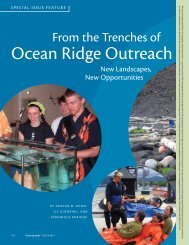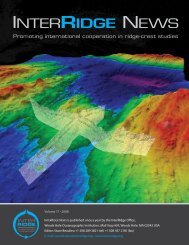Full version, low resolution, 7.5MB - InterRidge
Full version, low resolution, 7.5MB - InterRidge
Full version, low resolution, 7.5MB - InterRidge
Create successful ePaper yourself
Turn your PDF publications into a flip-book with our unique Google optimized e-Paper software.
National News<br />
Sulfur chimneys and CO 2 bubbles at the North Su Volcano,<br />
Eastern Manus Basin. (Photo: MARUM, University of Bremen).<br />
ultra-s<strong>low</strong> spreading Southwest Indian Ridge in Dec 2012 and Dec<br />
2013, b) Gerhard Bohrmann from MARUM will head a cruise to<br />
the Sandwich Plate in March 2013, and c) Antje Boetius (AWI and<br />
MPI-Bremen) will head the AURORA cruise to 83°N on the Gakkel<br />
Ridge in June 2014 using a new hybrid ROV/AUV system<br />
developed by WHOI for under-ice diving in a collaboration with<br />
Chris German from WHOI.<br />
And many plans are afoot to continue and expand German ridgerelated<br />
research. An international workshop held in Kiel in April<br />
2012 looked at the science drivers for a return to the TAG area and<br />
generated significant interest in a multi-year, multi-national effort to<br />
do a segment-scale study. Also in April 2012, a new transatlantic<br />
graduate school (Helmholtz School for Ocean System Science and<br />
Technology, HOSST: see www.hosst.org), proposed jointly by<br />
Geomar and the Halifax Marine Research Institution in Nova Scotia,<br />
was funded by the Helmholtz Association. The call for the first 11<br />
PhD positions was announced in June and included the possibility<br />
of working on the Mid-Atlantic Ridge. The Universities of Bremen<br />
and Kiel have, together with Geomar, taken the first steps towards<br />
formulating a proposal to the German Science Foundation for a 12-<br />
year special research program on the deep seafloor.<br />
Japan<br />
Kyoko Okino<br />
In reaction to the M9 earthquake on 11 March 2011, a substantial<br />
amount of ship time was devoted to monitoring radioactive levels<br />
offshore of Fukushima until September, and many urgent studies<br />
including aftershock surveys by OBSs, sea-bottom crustal<br />
displacement, surface environmental change etc. were carried out in<br />
2011. In this context, some ridge-related studies were forced to<br />
change schedule, but we try to continue our efforts to promote<br />
ridge-related studies in Japan and to expand our community. The<br />
outline of ongoing projects and other activities are described be<strong>low</strong>.<br />
Domestic and International Meetings<br />
An <strong>InterRidge</strong>-Japan symposium was held on 1-2 November 2011,<br />
at the Atmosphere and Ocean Research Institute (AORI), University<br />
of Tokyo. About sixty scientists participated in the symposium to<br />
share recent research activities. The second day of the symposium<br />
was dedicated to reviewing the Japanese ridge studies in this decade,<br />
and we discussed our scientific goals and strategies for the<br />
<strong>InterRidge</strong> third decade. We also had a business meeting on 22 May<br />
2012 at the Japan Geoscience Union Meeting, where we shared<br />
information on budget, cruise, workshops and international affairs,<br />
and discussed the <strong>InterRidge</strong>-Japan annual activity plan.<br />
We hosted the international workshop on ‘Ocean Mantle Dynamics:<br />
From Spreading Center to Subduction Zones’ led by the IR Mantle<br />
Imaging WG, 4-6 October 2011. 77 scientists from six different<br />
countries gathered at AORI to discuss recent developments in the<br />
study of the dynamics of the oceanic lithosphere, melt production<br />
at oceanic spreading centers and islands arcs, and associated topics.<br />
The meeting was supported by several organizations, including the<br />
Japanese TAIGA project, the US Geoprisms program, AORI and<br />
the Ocean Alliance of the University of Tokyo, as well as <strong>InterRidge</strong>.<br />
The meeting was preceded by a field trip to the Horoman Peridotite<br />
Complex in Hokkaido led by Eiichi Takazawa from Niigata<br />
University. The field trip party visited several outcrops of fresh<br />
lherzolite, harzburgite and dunite along the Horoman River uplifted<br />
and exposed by thrust faulting. The field trip party also had several<br />
presentations on the petrology and seismic imaging of the Horoman<br />
complex. The first day of the scientific meeting focused on the<br />
structure of the oceanic lithosphere and asthenosphere, with an<br />
emphasis on results of recent imaging studies and laboratory<br />
experiments. The second day’s topic was melt migration beneath<br />
spreading centers and the formation of oceanic crust. The third day<br />
reviewed geochemical and experimental evidence for the transport<br />
mechanism and distribution of water in arc/backarc systems. 26<br />
poster presentations, many of them from students and younger<br />
scientists, were a key part of the meeting, and they provoked a lot<br />
of good discussions at the poster time. <strong>InterRidge</strong> sponsored two<br />
awards for the best student poster presentations. Shusaku Yamazaki<br />
from Niigata University and Akiko Takeo from the Earthquake<br />
Research Institute of Tokyo University won the awards. The entire<br />
meeting program, including abstracts is available at:<br />
http://ofgs.aori.u-tokyo.ac.jp/intridgej/WS_2011/.<br />
INTERRIDGE NEWS 39 VOL.21, 2012
















